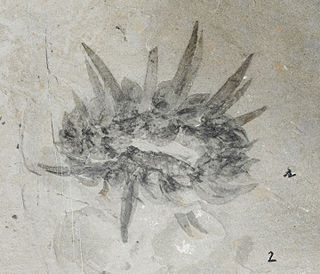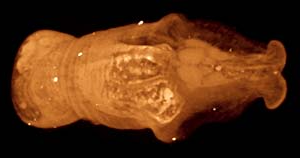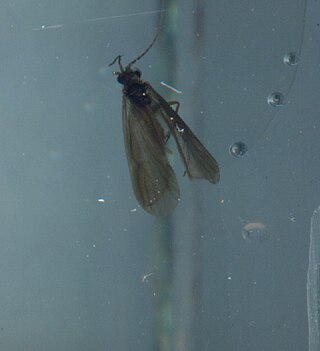
Wiwaxia is a genus of soft-bodied animals that were covered in carbonaceous scales and spines that protected it from predators. Wiwaxia fossils—mainly isolated scales, but sometimes complete, articulated fossils—are known from early Cambrian and middle Cambrian fossil deposits across the globe. The living animal would have measured up to 5 centimetres (2 in) when fully grown, although a range of juvenile specimens are known, the smallest being 2 millimetres (0.08 in) long.

Natrix is a genus of Old World snakes found mainly across Eurasia in the subfamily Natricinae of the family Colubridae. They are commonly called grass snakes and water snakes, but some other snake species also known commonly as "grass snakes" and "water snakes" are not in the genus.

Aplacophora is a presumably paraphyletic taxon. This is a class of small, deep-water, exclusively benthic, marine molluscs found in all oceans of the world.

The Solenogastres, common name the solenogasters, are one class of small, worm-like, shell-less molluscs (Aplacophora), the other class being the Caudofoveata (Chaetodermomorpha).

Henri François Pittier de Fabrega was a Swiss-born geographer and botanist who started Venezuelan National Park history.

Chaetoderma is a speciose genus of aplacophoran mollusc. It has forty described species at present.

Xanthodaphne is a genus of sea snails, marine gastropod mollusks in the family Raphitomidae.
Naskia is a genus of sea snails, marine gastropod mollusks in the family Horaiclavidae.

Gymnobela is a genus of sea snails, marine gastropod mollusks in the family Raphitomidae.

Benthomangelia is a genus of sea snails, marine gastropod mollusks in the family Mangeliidae.
Plawenia a genus of solenogasters, shell-less, worm-like, marine mollusks.
Helicoradomenia is a genus of solenogasters, shell-less, worm-like mollusks.

Falcidens is one of three genera within the family Chaetodermatida; its radula consists of a single row of teeth which are mineralized in crystalline hydroxyapatite, and its teeth are not periodically shed and replaced like in other molluscs. For details of the radula, see Radula#In caudofoveates.

Horaiclavidae is a family of predatory sea snails, marine gastropod mollusks in the superfamily Conoidea.
Aldisa albomarginata is a species of sea slug, a dorid nudibranch, a marine gastropod mollusk in the family Cadlinidae.

Gonçalo António da Silva Ferreira Sampaio was a Portuguese botanist.

Lype is a genus of net tube caddisflies in the family Psychomyiidae. There are more than 20 described species in Lype.

Holocentropus is a genus of tube maker caddisflies in the family Polycentropodidae. There are more than 40 described species in Holocentropus.
Claviderma is a genus of molluscs belonging to the family Prochaetodermatidae.

Phoebodus is an extinct genus of phoebodontiform total group elasmobranch, known from over a dozen species found worldwide spanning the middle to late Devonian, making it one of the oldest known total group elasmobranchs. Most species are only known from their isolated tricuspid teeth, but one species, Phoebodus saidselachus from the Late Devonian of Morocco, is known from a complete skeleton, estimated to have been 1.2 metres (3.9 ft) in total length in life, which shows that it had a slender body superficially similar to that of the living frilled shark. The teeth of Phoebodus and frilled sharks are also morphologically similar, and are designed for grasping prey. Phoebodus probably consumed small prey items that were capable of being swallowed whole.













